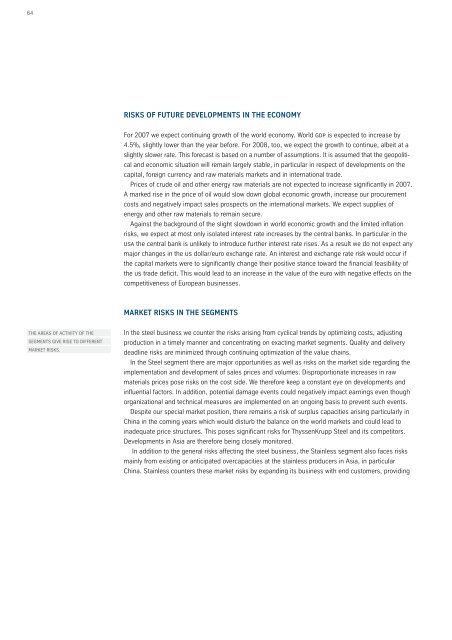2005-2006 Financial Statements and Management Report
2005-2006 Financial Statements and Management Report
2005-2006 Financial Statements and Management Report
You also want an ePaper? Increase the reach of your titles
YUMPU automatically turns print PDFs into web optimized ePapers that Google loves.
64<br />
THE AREAS OF ACTIVITY OF THE<br />
SEGMENTS GIVE RISE TO DIFFERENT<br />
MARKET RISKS.<br />
RISKS OF FUTURE DEVELOPMENTS IN THE ECONOMY<br />
For 2007 we expect continuing growth of the world economy. World gdp is expected to increase by<br />
4.5%, slightly lower than the year before. For 2008, too, we expect the growth to continue, albeit at a<br />
slightly slower rate. This forecast is based on a number of assumptions. It is assumed that the geopolitical<br />
<strong>and</strong> economic situation will remain largely stable, in particular in respect of developments on the<br />
capital, foreign currency <strong>and</strong> raw materials markets <strong>and</strong> in international trade.<br />
Prices of crude oil <strong>and</strong> other energy raw materials are not expected to increase significantly in 2007.<br />
A marked rise in the price of oil would slow down global economic growth, increase our procurement<br />
costs <strong>and</strong> negatively impact sales prospects on the international markets. We expect supplies of<br />
energy <strong>and</strong> other raw materials to remain secure.<br />
Against the background of the slight slowdown in world economic growth <strong>and</strong> the limited inflation<br />
risks, we expect at most only isolated interest rate increases by the central banks. In particular in the<br />
usa the central bank is unlikely to introduce further interest rate rises. As a result we do not expect any<br />
major changes in the us dollar/euro exchange rate. An interest <strong>and</strong> exchange rate risk would occur if<br />
the capital markets were to significantly change their positive stance toward the financial feasibility of<br />
the us trade deficit. This would lead to an increase in the value of the euro with negative effects on the<br />
competitiveness of European businesses.<br />
MARKET RISKS IN THE SEGMENTS<br />
In the steel business we counter the risks arising from cyclical trends by optimizing costs, adjusting<br />
production in a timely manner <strong>and</strong> concentrating on exacting market segments. Quality <strong>and</strong> delivery<br />
deadline risks are minimized through continuing optimization of the value chains.<br />
In the Steel segment there are major opportunities as well as risks on the market side regarding the<br />
implementation <strong>and</strong> development of sales prices <strong>and</strong> volumes. Disproportionate increases in raw<br />
materials prices pose risks on the cost side. We therefore keep a constant eye on developments <strong>and</strong><br />
influential factors. In addition, potential damage events could negatively impact earnings even though<br />
organizational <strong>and</strong> technical measures are implemented on an ongoing basis to prevent such events.<br />
Despite our special market position, there remains a risk of surplus capacities arising particularly in<br />
China in the coming years which would disturb the balance on the world markets <strong>and</strong> could lead to<br />
inadequate price structures. This poses significant risks for ThyssenKrupp Steel <strong>and</strong> its competitors.<br />
Developments in Asia are therefore being closely monitored.<br />
In addition to the general risks affecting the steel business, the Stainless segment also faces risks<br />
mainly from existing or anticipated overcapacities at the stainless producers in Asia, in particular<br />
China. Stainless counters these market risks by exp<strong>and</strong>ing its business with end customers, providing

















